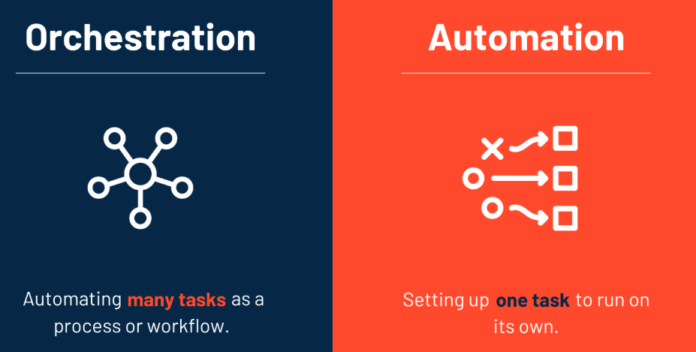Automation and Network Orchestration are two terms that often get mixed up. Network orchestration is the process of managing networks to increase efficiency and productivity. Automation is a software program, as an app on your phone or computer, which performs tasks automatically without any user intervention required. Network orchestration will allow you to automate routine tasks while also increasing efficiencies in the network by coordinating all of its components together.
But what’s the difference? What do these terms mean, and how does it impact their day-to-day operations? In this article, we will define these terms and explore why Network Orchestration has become so popular in recent years.
What is Network Orchestration?
So, what is network orchestration? Network Orchestration is the process of managing multiple networking components to increase efficiency and productivity. Network orchestration software will automate tasks and coordinate all of its components together to optimize your network’s performance.
For example, network orchestration tools can be used to automatically update firmware on switches when it detects a problem with them or installs patches to keep the network safe from viruses and malware. Network orchestration can also help resolve configuration conflicts that arise, as well as increase security by only allowing authorized devices onto your network.
You may be wondering – why does Network Orchestration matter so much? Well, Network Orchestration is becoming increasingly important in a world where our reliance on technology continues to grow. Network orchestration will automate certain routine tasks but also increases efficiency by coordinating all of your network’s components together to create a more stable environment for you and your team.
What is IT Automation?
Automation software programs will allow you to automate routine tasks. It can be used on your phone or computer and performs certain actions automatically without any input from the user. Automation takes place in both hardware and software components of an IT network – allowing it to function more smoothly together than if they were not automated at all. IT automation is becoming increasingly important to businesses of all sizes, as it reduces the amount of time required for employees to complete tasks.
For example, automated printers can be programmed so that they only print when someone needs them and will shut off after a certain period of inactivity (saving money) – all from your smartphone. Automation also helps resolve configuration conflicts between devices automatically, as well as increase security by only allowing authorized devices onto your network.
What Makes Automation and Orchestration Different?
Though Network Orchestration and IT Automation are closely related, they should never be confused with one another. Network orchestration coordinates all of its components together to create a more stable environment for you and your team. In contrast, automation software programs will allow you to automate certain tasks performed in the hardware or software components on an IT Network. For example, Network Orchestration also helps resolve configuration conflicts between devices automatically, increases security by authorizing specific individuals to access the system via their IP address/ ID, etc., but it also coordinates all of its components together to optimize your Network’s performance. So Network Orchestration and IT Automation are closely related, but they should never be confused with one another.
Automating certain processes within an IT Network provides much-needed stability. It allows employees more time to focus on other important projects/tasks that require their attention, ultimately leading to increased productivity among the team. Network Orchestration and automation both play an important role in the Networking world, but it is ultimately up to you which management aspect you prefer for your Network environment – though effective Network/IT Management most often lies within Network orchestration abilities.
Benefits of Orchestration
- Network orchestration helps reduce Network downtime
- Network/IT orchestration improves business intelligence and productivity across the organization.
- Can help resolve configuration conflicts
Benefits of Automation
- Automation saves time by allowing Network Administrators to focus on other important projects
- Automation allowing the IT network to function smoothly
Conclusion
Understanding the difference between automation and orchestration is important because they help Network Administrators manage, monitor, and optimize their IT Network effectively. They both play an important role in the Networking world. So make sure you understand which management aspect suits your Network environment best.
Also Read: Brief Guide to the Internets First Surviving Network











